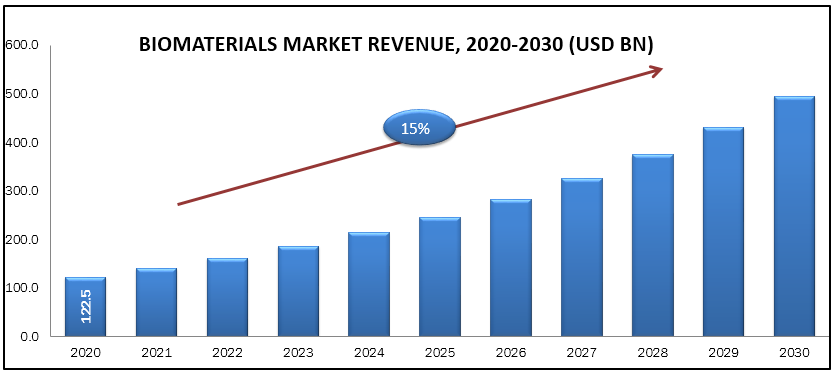Biomaterial Market size was valued at USD 122.5 billion in 2020 and it expected to reach USD 495.5 billion by 2030, register the CAGR of 15.0% during the forecast period.A biomaterial is a natural or synthetic material that is suitable for introduction into living tissue, especially used for medical purposes. It is designed to cure the affected body part without harming other organs. Owing to its use in dental implants, bone and joint replacements, capsules and pacemakers, biomaterials are highly beneficial to people. They are strong and resistant to fatigue degradation. They have shape memory and can be sterilized well before use. Attributed to the increased use in implantable devices, growing government initiatives for advanced healthcare facilities, rising incidents of CVD.
Market Segmentation:
On the basis of type, the biomaterial market is majorly segmented into metallic, polymeric, ceramic and, natural. By application, cardiovascular, orthopaedic, dental, plastic surgery, wound healing, neurological disorders, tissue engineering and, ophthalmology. By region, the biomaterial market is classified into North America, Europe, and Asia Pacific, and ROW.
Market Dynamics and Factors:
Rising geriatric population, advancements in medicinal technologies, government funds in launching new products such as implant devices for knee and hip replacement surgeries are the major factors driving the global biomaterial market. High cost of production, wear and tear of implantable products, complications in the use are the major factors hampering the biomaterial market growth. In addition to this, strict rules & regulations and government approvals for the use of certified materials are also restraining the biomaterial market. However, developments in ceramic biomaterials for the repair of hard tissues in orthopaedics and plant & animal based biomaterials such as cellulose, natural rubbers, collagen and, HAG ( hyaluronic acid glycosaminoglycans) are likely to propel the market growth leading to high revenue generation. Furthermore, PPP (Private Public Partnership) in the industrial sector is expected to bring new opportunities. Growing demand and production of sensors, guide wires, implantable cardiac defibrillators, and vascular grafts in the cardiovascular segment is anticipated to positively impact the biomaterial market in the upcoming years.
Geographic Analysis:
North America is currently dominating the market due to increasing number of angiography procedures, growing demand for plastic surgeries, and large number of conferences on product use. Owing to this, North America is expected to show significant growth in the forthcoming years, closely followed by Europe. Furthermore, APAC is anticipated to witness the highest CAGR during the forecast period. This is attributed to Japan’s growing advancements in healthcare sector, growing prevalence of cardiovascular diseases in India and China. Moreover, recent developments like the partnership of Royal DSM (Netherlands) with a U.S. based company ProMed Pharma to develop novel sustained release drug delivery solutions is expected to fuel the biomaterial market growth in the years to come.
Competitive Scenario:
Key players in the biomaterial market include CoorStek Inc., CeramTec, Celanese Corporation, Berkeley Advanced Biomaterials, Cam Bioceramics B.V., Evonik Industries, Royal DSM, and BASF SE.
Biomaterials Market Report Scope
| Report Attribute | Details |
| Analysis Period | 2020–2030 |
| Base Year | 2021 |
| Forecast Period | 2022–2030 |
| Market Size Estimation | Billion (USD) |
| Growth Rate (CAGR%) | 15 % |
|
| By Type (Metallic, Polymeric, Ceramic, and Natural), By Application (Cardiovascular, Orthopedic, Dental, Plastic Surgery, Wound Healing, Neurological Disorders, and Tissue Engineering & Ophthalmology) |
| Geographical Segmentation | North America (U.S., Canada, Mexico) Europe (UK, Germany, Italy, France, Rest of Europe), Asia-Pacific (China, Japan, India, Australia, Rest of APAC), South America (Brazil, Argentina, Rest of SA), MEA (UAE, Saudi Arabia, South Africa) |
| Key Companies Profiled | CoorStek Inc., CeramTec, Celanese Corporation, Berkeley Advanced Biomaterials, Cam Bioceramics B.V., Evonik Industries, Royal DSM, and BASF SE. |







